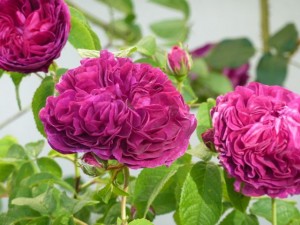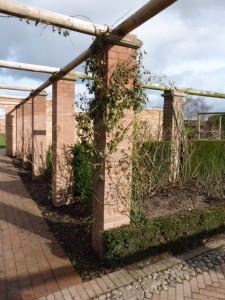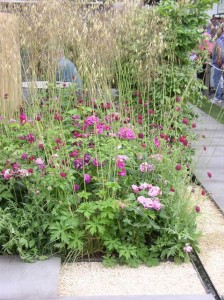
March has crept in overcast and hand-wringing in East Anglia. Late into the rose buying season, bare -rooted time, its a good moment to distract from grey by buying roses. You will be far better off buying dormant roses, lifted from the ground and dispatched with roots freed from any soil.
So how do you choose? Colour? Blooms? Scent? For a kick-off, forget all that. Look in a book or catalogue.
[caption id="attachment_1171" align="alignleft" width="225" caption="Princess Louise rambler"]

[/caption]
The large velvety blooms of the hybrid teas nod their heads beguilingly - which should it be: rumpled yellow or 50s pink ball dress with hips to match? I fall for it every time, those full facial close-ups on shiny paper. But with plants, this is choosing back to front. Advice follows which is to roses as Vidal Sassoon was to hair-cuts. First, we need to consider the effect required and THEN select the plant.
There is also shape, form and habit to consider. Shape is the two dimensional silhouette of the plant. Fill in the outline with density of leaf, quantity of branches and so on arrive at form. Then add the branching pattern - is the rose shrub upright, trailing, lax or rigid and study the foliage. Is it semi evergreen? what colour are new leaves and do mature ones reflect light? By now you will have gained a good understanding of how that particular rose performs. A good start.
Add to this - vigour. How big does the rose grow? A vital statistic with all climbers as you could inadvertently harbour a tree-slaying monster. Always check listed height.
How disease resistant is that type? Much better to select stocky, self nurturing plants rather than spraying a sickly specimen that keeps shedding leaves.
Suitability to aspect comes next - is the site exposed or for instance a north facing wall? And then we come to colour and scent and length of flowering season.
[caption id="attachment_1174" align="alignleft" width="224" caption="Chelsea garden 2005 with Rosa Mundi"]

[/caption]
The rose books can have a buckling effect - the Alba, Damask, Hybrid Perpetual jargon is very confusing and so, for simplicity, we are going to define our roses by where they grow in the garden.
We will start with the wild and work our way in. This is the realm of the imaginary garden. In your mind put yourself in the long grass near woodland and turn back to face the house.
A sizable tree is perfect for a vigorous rambler. There is a range of vast great roses to go into large trees.
Rosa filipes Kiftsgate/ R. Rambling Rector//R. Paul’s Himalayan Musk
Smaller and more polite versions for growing into say, your almond or cherry tree:
R.Climbing Cecile Brunner/Felicitie et Perpetue/The Alchymist
It’s a good place to have large wild clumps of roses in the grass - for shapes there are fountain roses making an elegant vertical spray.
Rosa rubrifolia/R moyesii/R sericia Pteracantha/R. Xanthina var. Spontanea ‘Canary Bird’.
Or a more cloud clump shape may be more suitable. Choose from:
Rosa rugosa Blanc Double de Coubert/Roseraie de l’Hay/R. Fru Dagmar Hastrup/Tuscany Superb
Roses make a wonderful informal hedge- here are some suggestion beginning with the larger in size;
Rugosas as above/
R alba maxima/R. gallica Officinalis/Rosa Mundi
Covering bare ground and banks:
Ramblers (experimental)
Rosa Grouse/Rosa Partridge/R. spinosissima/R Dunwich Rose

A wonderful break between the formal and informal parts of the garden is a pergola or trellis or ropes or chains looped between posts. The latter is a particularly good way of growing ramblers. A choice of the more polite ramblers:
R.Adelaide d’Orleans/Albertine/Crimson Showers/Veilchenblau
Ramblers vary from climbers in that they send up shoots from the base of the plant and flowers are borne in trusses.
[caption id="attachment_1173" align="alignleft" width="300" caption="trellis at Rousham"]

[/caption]
The climbing roses can share the pergola or posts - it is best to train them so that branches are plaited round (habit permitting) - this will promote intensity of flowering. They will be equally good grown up the house on wires as long as branches are spread wide horizontally. If the stems can be arched to a horizontal or downward pointing position, buds will break all along stems under the window. So train rose out and round.
Choose with care so that rose does not outgrow its allotted space.
R.The New Dawn/Blairii no 2/ Gloire de Dijon and, amongst David Austin Climbers (less vigorous altogether)
R. Teasing Georgia/The Constant Gardener.
We have arrived at last at the flower bed roses - you can use the old fashioned roses but remember that some are greedy of space (more of this in pruning and training) and may only flower once. Otherwise remember the strictures of vigor, etc etc and choose from amongst English Roses or Hybrid Teas or Floribundas - the choice is limitless. Last of all you may want to punctuate with formality by introducing standards.
 March has crept in overcast and hand-wringing in East Anglia. Late into the rose buying season, bare -rooted time, its a good moment to distract from grey by buying roses. You will be far better off buying dormant roses, lifted from the ground and dispatched with roots freed from any soil.
So how do you choose? Colour? Blooms? Scent? For a kick-off, forget all that. Look in a book or catalogue.
[caption id="attachment_1171" align="alignleft" width="225" caption="Princess Louise rambler"]
March has crept in overcast and hand-wringing in East Anglia. Late into the rose buying season, bare -rooted time, its a good moment to distract from grey by buying roses. You will be far better off buying dormant roses, lifted from the ground and dispatched with roots freed from any soil.
So how do you choose? Colour? Blooms? Scent? For a kick-off, forget all that. Look in a book or catalogue.
[caption id="attachment_1171" align="alignleft" width="225" caption="Princess Louise rambler"] [/caption]
The large velvety blooms of the hybrid teas nod their heads beguilingly - which should it be: rumpled yellow or 50s pink ball dress with hips to match? I fall for it every time, those full facial close-ups on shiny paper. But with plants, this is choosing back to front. Advice follows which is to roses as Vidal Sassoon was to hair-cuts. First, we need to consider the effect required and THEN select the plant.
There is also shape, form and habit to consider. Shape is the two dimensional silhouette of the plant. Fill in the outline with density of leaf, quantity of branches and so on arrive at form. Then add the branching pattern - is the rose shrub upright, trailing, lax or rigid and study the foliage. Is it semi evergreen? what colour are new leaves and do mature ones reflect light? By now you will have gained a good understanding of how that particular rose performs. A good start.
Add to this - vigour. How big does the rose grow? A vital statistic with all climbers as you could inadvertently harbour a tree-slaying monster. Always check listed height.
How disease resistant is that type? Much better to select stocky, self nurturing plants rather than spraying a sickly specimen that keeps shedding leaves.
Suitability to aspect comes next - is the site exposed or for instance a north facing wall? And then we come to colour and scent and length of flowering season.
[caption id="attachment_1174" align="alignleft" width="224" caption="Chelsea garden 2005 with Rosa Mundi"]
[/caption]
The large velvety blooms of the hybrid teas nod their heads beguilingly - which should it be: rumpled yellow or 50s pink ball dress with hips to match? I fall for it every time, those full facial close-ups on shiny paper. But with plants, this is choosing back to front. Advice follows which is to roses as Vidal Sassoon was to hair-cuts. First, we need to consider the effect required and THEN select the plant.
There is also shape, form and habit to consider. Shape is the two dimensional silhouette of the plant. Fill in the outline with density of leaf, quantity of branches and so on arrive at form. Then add the branching pattern - is the rose shrub upright, trailing, lax or rigid and study the foliage. Is it semi evergreen? what colour are new leaves and do mature ones reflect light? By now you will have gained a good understanding of how that particular rose performs. A good start.
Add to this - vigour. How big does the rose grow? A vital statistic with all climbers as you could inadvertently harbour a tree-slaying monster. Always check listed height.
How disease resistant is that type? Much better to select stocky, self nurturing plants rather than spraying a sickly specimen that keeps shedding leaves.
Suitability to aspect comes next - is the site exposed or for instance a north facing wall? And then we come to colour and scent and length of flowering season.
[caption id="attachment_1174" align="alignleft" width="224" caption="Chelsea garden 2005 with Rosa Mundi"] [/caption]
The rose books can have a buckling effect - the Alba, Damask, Hybrid Perpetual jargon is very confusing and so, for simplicity, we are going to define our roses by where they grow in the garden.
We will start with the wild and work our way in. This is the realm of the imaginary garden. In your mind put yourself in the long grass near woodland and turn back to face the house.
A sizable tree is perfect for a vigorous rambler. There is a range of vast great roses to go into large trees.
Rosa filipes Kiftsgate/ R. Rambling Rector//R. Paul’s Himalayan Musk
Smaller and more polite versions for growing into say, your almond or cherry tree:
R.Climbing Cecile Brunner/Felicitie et Perpetue/The Alchymist
It’s a good place to have large wild clumps of roses in the grass - for shapes there are fountain roses making an elegant vertical spray.
Rosa rubrifolia/R moyesii/R sericia Pteracantha/R. Xanthina var. Spontanea ‘Canary Bird’.
Or a more cloud clump shape may be more suitable. Choose from:
Rosa rugosa Blanc Double de Coubert/Roseraie de l’Hay/R. Fru Dagmar Hastrup/Tuscany Superb
Roses make a wonderful informal hedge- here are some suggestion beginning with the larger in size;
Rugosas as above/ R alba maxima/R. gallica Officinalis/Rosa Mundi
Covering bare ground and banks:
Ramblers (experimental) Rosa Grouse/Rosa Partridge/R. spinosissima/R Dunwich Rose
[/caption]
The rose books can have a buckling effect - the Alba, Damask, Hybrid Perpetual jargon is very confusing and so, for simplicity, we are going to define our roses by where they grow in the garden.
We will start with the wild and work our way in. This is the realm of the imaginary garden. In your mind put yourself in the long grass near woodland and turn back to face the house.
A sizable tree is perfect for a vigorous rambler. There is a range of vast great roses to go into large trees.
Rosa filipes Kiftsgate/ R. Rambling Rector//R. Paul’s Himalayan Musk
Smaller and more polite versions for growing into say, your almond or cherry tree:
R.Climbing Cecile Brunner/Felicitie et Perpetue/The Alchymist
It’s a good place to have large wild clumps of roses in the grass - for shapes there are fountain roses making an elegant vertical spray.
Rosa rubrifolia/R moyesii/R sericia Pteracantha/R. Xanthina var. Spontanea ‘Canary Bird’.
Or a more cloud clump shape may be more suitable. Choose from:
Rosa rugosa Blanc Double de Coubert/Roseraie de l’Hay/R. Fru Dagmar Hastrup/Tuscany Superb
Roses make a wonderful informal hedge- here are some suggestion beginning with the larger in size;
Rugosas as above/ R alba maxima/R. gallica Officinalis/Rosa Mundi
Covering bare ground and banks:
Ramblers (experimental) Rosa Grouse/Rosa Partridge/R. spinosissima/R Dunwich Rose
 A wonderful break between the formal and informal parts of the garden is a pergola or trellis or ropes or chains looped between posts. The latter is a particularly good way of growing ramblers. A choice of the more polite ramblers:
R.Adelaide d’Orleans/Albertine/Crimson Showers/Veilchenblau
Ramblers vary from climbers in that they send up shoots from the base of the plant and flowers are borne in trusses.
[caption id="attachment_1173" align="alignleft" width="300" caption="trellis at Rousham"]
A wonderful break between the formal and informal parts of the garden is a pergola or trellis or ropes or chains looped between posts. The latter is a particularly good way of growing ramblers. A choice of the more polite ramblers:
R.Adelaide d’Orleans/Albertine/Crimson Showers/Veilchenblau
Ramblers vary from climbers in that they send up shoots from the base of the plant and flowers are borne in trusses.
[caption id="attachment_1173" align="alignleft" width="300" caption="trellis at Rousham"] [/caption]
The climbing roses can share the pergola or posts - it is best to train them so that branches are plaited round (habit permitting) - this will promote intensity of flowering. They will be equally good grown up the house on wires as long as branches are spread wide horizontally. If the stems can be arched to a horizontal or downward pointing position, buds will break all along stems under the window. So train rose out and round.
Choose with care so that rose does not outgrow its allotted space.
R.The New Dawn/Blairii no 2/ Gloire de Dijon and, amongst David Austin Climbers (less vigorous altogether)R. Teasing Georgia/The Constant Gardener.
We have arrived at last at the flower bed roses - you can use the old fashioned roses but remember that some are greedy of space (more of this in pruning and training) and may only flower once. Otherwise remember the strictures of vigor, etc etc and choose from amongst English Roses or Hybrid Teas or Floribundas - the choice is limitless. Last of all you may want to punctuate with formality by introducing standards.
[/caption]
The climbing roses can share the pergola or posts - it is best to train them so that branches are plaited round (habit permitting) - this will promote intensity of flowering. They will be equally good grown up the house on wires as long as branches are spread wide horizontally. If the stems can be arched to a horizontal or downward pointing position, buds will break all along stems under the window. So train rose out and round.
Choose with care so that rose does not outgrow its allotted space.
R.The New Dawn/Blairii no 2/ Gloire de Dijon and, amongst David Austin Climbers (less vigorous altogether)R. Teasing Georgia/The Constant Gardener.
We have arrived at last at the flower bed roses - you can use the old fashioned roses but remember that some are greedy of space (more of this in pruning and training) and may only flower once. Otherwise remember the strictures of vigor, etc etc and choose from amongst English Roses or Hybrid Teas or Floribundas - the choice is limitless. Last of all you may want to punctuate with formality by introducing standards.
